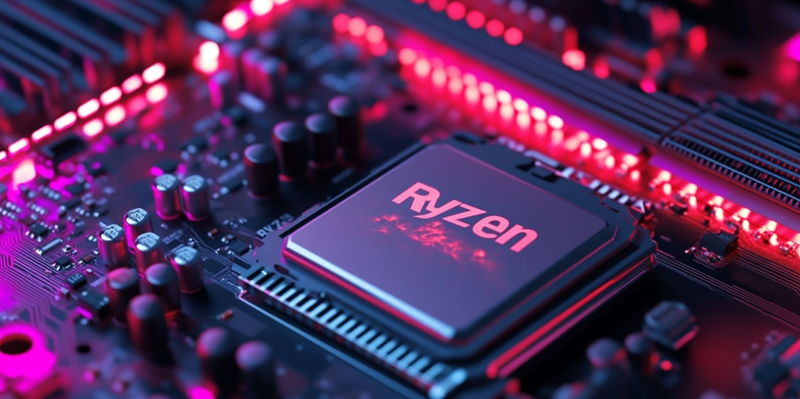Gigabyte recently introduced a feature called "X3D Turbo Mode" in its AM5 motherboards, aiming to enhance the gaming performance of AMD Ryzen 9000X3D processors. This mode, which was included in the AGESA 1.2.0.2a BIOS update, offers support not only for the X3D Ryzen 9000 series but also for the non-X3D Ryzen 9000 and 7000 CPUs. Gigabyte initially claimed this feature could boost gaming performance by up to 35% for Ryzen 9000X3D processors and up to 20% for other Ryzen 9000 models.
Mixed Results from Performance Tests
Modest Improvements for Ryzen 7 9800X3D
However, recent tests indicate that the performance uplift is nowhere near as significant as Gigabyte’s initial claims suggested. For instance, the AMD Ryzen 7 9800X3D achieved a modest 3-5% improvement across three tested games: Horizon Zero Dawn (+4.5%), Tomb Raider (+5.01%), and Far Cry 6 (+3.56%). Despite Tomb Raider being a GPU-intensive game, these gains are relatively modest and far from the initially promised figures. This discrepancy raises questions about the real-world applicability and effectiveness of the X3D Turbo Mode for gaming.
The modest performance gains for the Ryzen 7 9800X3D processor were certainly unexpected, given the high expectations set by Gigabyte. The slight improvements in gaming performance, though observable, are not particularly groundbreaking. Gamers who were anticipating a considerable boost in their gaming experience might find these results disappointing. Although the X3D Turbo Mode does offer some enhancements, they fall short of the hype that surrounded its release.
Significant Gains for Higher-End CPUs
In contrast, data showed more substantial gains for higher-end processors like the Ryzen 9 9950X and the Ryzen 7 7950X3D. Specifically, the Ryzen 9 9950X saw an uplift of 18%, while the Ryzen 7 7950X3D achieved a maximum improvement of 16%. Performance gains for these CPUs varied by game, with the most notable increases observed in Far Cry 6, where the 9950X and 7950X3D showed impressive gains of +17.98% and +16.14%, respectively. These results suggest that while the X3D Turbo Mode may not provide significant boosts across all processors, it does have potential benefits for high-end models.
The more substantial performance gains observed in higher-end CPUs indicate that the X3D Turbo Mode’s efficacy may be more pronounced in top-tier processors. These findings suggest that gamers using the Ryzen 9 9950X or the Ryzen 7 7950X3D might experience a more noticeable improvement in their gaming performance. However, it is evident that these enhancements are game-specific and may not translate uniformly across all titles. This variability further underscores the need for more independent benchmarks to offer a comprehensive evaluation of the X3D Turbo Mode.
Technical Aspects and User Experience
Core Distribution and DRAM Dependency
Gigabyte’s X3D Turbo Mode adjusts several technical parameters, including core distribution, bandwidth tuning, and hardware power balancing, to prioritize gaming performance. The mode is also DRAM-dependent, implying that higher memory speeds could potentially lead to further performance improvements. Users can monitor the status of the X3D Turbo Mode through the AI Snatch feature available in Gigabyte’s Control Center application. This level of customization and real-time monitoring provides gamers with tools to optimize their gaming experience based on their specific hardware configurations.
The technical adjustments made by the X3D Turbo Mode aim to optimize various aspects of the system to enhance gaming performance. By fine-tuning core distribution and bandwidth, the mode strives to allocate resources more efficiently, ensuring that gaming receives the utmost priority. The dependency on DRAM suggests that users with high-speed memory modules might see additional gains, further enhancing the gaming experience. However, these technical nuances highlight that the actual benefits of the X3D Turbo Mode may vary based on individual system configurations.
Expectations and Future Evaluations
Gigabyte recently unveiled a new feature called "X3D Turbo Mode" for its AM5 motherboards, designed to enhance the gaming performance of AMD Ryzen 9000X3D processors. This exciting new mode comes as part of the AGESA 1.2.0.2a BIOS update. What’s great about this feature is that it not only supports the X3D Ryzen 9000 series, but also the non-X3D Ryzen 9000 and 7000 CPUs.
According to Gigabyte, "X3D Turbo Mode" has the potential to significantly boost gaming performance. They initially claimed it could enhance the gaming experience by up to 35% for Ryzen 9000X3D processors. Other Ryzen 9000 models might also see a considerable improvement, with performance gains projected at up to 20%. This development represents a major step forward for gamers looking to maximize the capabilities of their systems, making the Ryzen 9000 series an even more attractive option for those seeking top-tier gaming performance.

